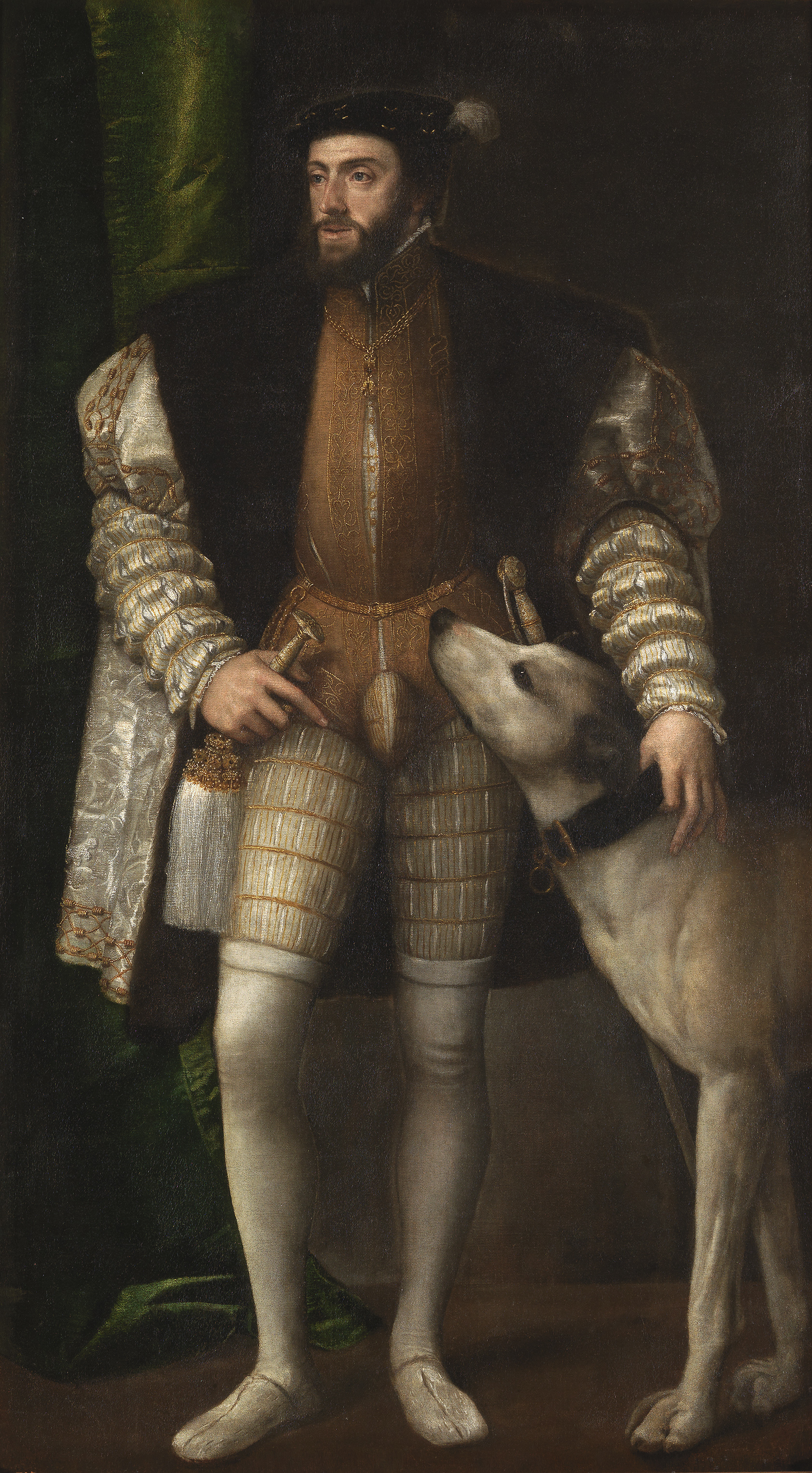
Mysterious cult of a Saint Hound

A few years ago, when I wrote about looted middle part of Lusina altarpiece (National Museum in Cracow, war loss – post available HERE) I mentioned several – often contradictory – interpretations for a dog in medieval art. On one hand it could have symbolised faithfulness, but on the other it could have personified stupidity, impurity or the devil himself.
Naturally, dogs in medieval Europe accompanied people of all the social groups. They would appear in the lives of saints, as well as in courtly art; especially the hounds, taking part in the elites’ favourite entertainment, that is: hunting. In this context, dogs started to be regarded as social status’ symbol, and so in the Early Modern times many portraits featured dogs as attributes of aristocracy.

Titian, Emperor Charles V with a Dog, 1533, Prado
https://www.museodelprado.es/en/the-collection/art-work/the-emperor-charles-v-with-a-dog/c6945b08-ded2-4824-9ac1-9a1d042549ce
The term „Saint dog” always makes me think about St Christopher, who – according to some legends – was supposed to had been a cynocephalus (a man with canine head) and that is how he was depicted in some icons. Here again let me recommend you my earlier post on the subject (available HERE). Nonetheless, I learned that there was another venerated dog, who was just an animal: he was called St Guinefort.
St Guinefort’s legend was written down by a Dominican Étienne de Bourbon in 1250 – he described it as a curiosity he came across in Dombes (a rural area north of Lyon). It turned out that the local community venerated a dog they considered a martyr. That dog was said to had been killed by his own master: a knight who thought that the dog killed his baby. Apparently the knight (or a baby’s nanny) found a cradle turned over, and a dog with blood on its mouth. The knight killed the dog and only afterwards discovered that the baby was safe, asleep on the floor after falling out of the cradle, while nearby there was a carcass of a snake. Blood on Guinefort’s mouth was actually snake’s, because the brave dog killed the snake to save the baby. The knight was very sorry when he realised he unjustly executed his faithful companion; he buried Guinefort with respect, and soon the dog’s grave became a place where miracles happened. Local people believed that praying to Guinefort was helpful especially for healing sick children.

Johannes de Capua, “Directorium humanae vitae”, Strasbourg: Johann Prüss, c. 1489.
https://www.christies.com/en/lot/lot-5909288
Interestingly, this storyline is actually a popular motif, recurring in folk tales of many cultures. It is most likely rooted in ancient India, while later Arabic version was translated into Greek, Latin and Hebrew. In Sanskrit tale the hero was actually a mongoose – an animal known for its ability to kill a cobra. As both cats and mongooses repelled snakes, rats and other pests, they were kept as pets in ancient Egyptian temples, and indeed venerated in that culture. In the Northern-European version of the tale, mongoose was replaced with a hound. Apart from the French Guinefort, there is also Gelert from Wales.
He owner of the dog named Gelert was actually Llywelyn the Great, Prince of Wales living at the turn of the 12th and 13th centuries. The story is pretty much the same as in case of Guinefort – except that the dog protected the baby not from the snake, but from the wolf.
In the village called Beddgelert we may find Gelert’s grave, and the place’s name is supposed to deriver from it. But that is another legend, most likely created in Early Modern times to boost tourism in the area; nowadays most of the scholars assume that in fact the village’s name (meaning “Geller’s grave”) was originally related to St Gelert the hermit (also called Celer, Celert, or Kellarth), living in the 7th century. Also, we should remember that this St Gelert had nothing to do with St Gerard the martyr, called by the Hungarians “St Gellert”, after whom the Gellért Hill in Budapest was named.
But let’s get back to the 13th-century France; Étienne de Bourbon, however a Dominican (they were called “Lord’s dogs”, Lat. “domini canes”), did not approve veneration of a hound. He described how he supervised public exhumation and burning of the remains of the dog (so in the grave there were indeed canine bones). It did not work though; according to later sources, women seeking for healing of their sick children visited St Guinefort’s grave for several subsequent centuries.
However, Étienne was not particularly against animals; he rather was trying to fight superstitions and pagan rites. From his writings we may learn that certain disturbing ceremonies were conducted on Guinefor’s burial site, in order to “heal” infants. During those ceremonies, women called spirits of the woods (“fauns”) and asked them to take back the sickly child (believed to had been a changeling) and give back the real, healthy baby that the fauns spirited away earlier. At some point of the ritual women would put a naked infant on the ground and leave them alone for the time of burning out of a candle. That would often result in the baby’s death: by fever or by wild animals. As dr. Rebecca Rist wrote (in her article “The Papacy, Inquisition and Saint Guinefort the Holy Greyhound”), this rite not only seems pagan and magic, but also reminds of certain behaviour condemned by the Church. As the bishops Ivo of Chartres (d. 1115/6) or Burchard of Worms (d. 1025) mentioned, women would sometimes willingly neglect their problematic or sickly babies, by leaving them unsupervised or by placing them outside in the cold, hoping for the child to die of what would seem like natural causes rather than infanticide. Turning such practices into religious ritual was probably helpful in relieving the mothers’ consciouses, and that was most likely the most problematic aspect of the cult of St Guinefort. It surely disturbed Étienne de Bourbon more than actual blasphemy of venerating an animal.

Charles Burton Barber (1845–1894), “Gelert”, Reading Museum & Town Hall, https://artuk.org/discover/artworks/gelert-41537
Naturally, the legend about a faithful dog that saved an infant became popular again in art of the turn of the 19th and 20th centuries; back then all the regional medieval tales enjoyed renaissance of popularity. Later, the storyline was actually used by Walt Disney in his 1955 movie “Lady and the Tramp”; but of course as in case of the other Disney movies, there is a happy ending, so the dog does not get killed. Pop-culture therefore preserved a tale of a brave dog, luckily forgetting about ancient rites justifying infanticide, merged with weird veneration of a saint hound.





